
|   |

|   |
 e-mail: sunilkothari1933@gmail.com Festival of Festivals: 43rd year of Khajuraho Dance Festival - 1 Photos: Vijay Rohatgi March 4, 2017 I know of no other dance festival in India which has continuously lasted for more than forty two years. This is the forty third year of Khajuraho Dance Festival (Feb 20-26) with extended art activities transforming the venue into a multi-art event, engaging cross section of visitors to Khajuraho, be they tourists from within India and abroad, performing artists, painters, sculptors, litterateurs, film buffs, photographers, musicians, event managers, bureaucrats, dance critics, or common men who out of sheer curiosity walk into the grounds where for seven days from ten in the morning till ten in the night there is enough for each one to savour, relish. 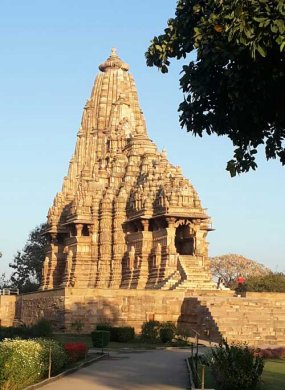 Khandarya Mahadeo temple Having been associated with the festival from early years, I see its growth from mere presentation of the dance forms to dialogues with dancers, art historians, critics, thinkers, film makers, theatre workers, painters, photographers and from this year beginning a new series of interacting with neighbouring countries, beyond borders, drawing attention to interconnectedness, sharing common traditions, that transcend gender, caste, religion and bring to one an awareness of human quality but also universal truth, offer space to reflect and elevate one through art to a higher level not only of enjoyment but also to involve and care and concern for people. I have been attending the festival again since last three years and am delighted to share with readers the magic spell the festival is casting with these added activities. I have shared with a team of people and in particular Rahul Rastogiji, along with Chinmayji, their vision which with Rahulji's natural leadership quality and ability to galvanize his colleagues and convince the government officers to raise the bar of the festival. Right from turning the ground in to a festival area, where workshops with crafts people, who mould shapes from earth into objects of art, earthen wares, the weavers that weave magic with warp and weft, their looms, the boundless variety of handloom, handicraft, textiles from different parts of the country, the exhibition Art Mart of painters mainly from Madhya Pradesh, sculptors, venue for Kalavarta, also sharing in the afternoon screening of documentary films not generally seen, but carefully selected, involving actor Raja Bundela, and at a special enclosure Nepathya where each year focusing on a particular state and its dance heritage with exhibition of costumes, masks, objects of rituals, floor paintings, designs, and performances between 6 and 7pm and then leading audiences to main event of dance with the backdrop of Chitragupta temple metamorphosing the ambience transporting onlookers to a dream world. Stars shooting in all directions, crescent moon resting like ardha Chandra on jata of Lord Shiva, appearing in sky above, resting on shikhara of the temple prepare the audience to relish the classical dance forms with enchanting music. To weave around the main event of dance, all that I have mentioned above is fascinating. And when the dancer appears in solo from the side to strains of music its appeal visually is stunning. The temple provides a context, a setting for unfolding of mythological stories, which dancer enacts, stringing the chords and evoking archetypal memories. Be it a prayer to Sun God, or Ganesha or Lord Shiva, the audience gets ready to receive it in moments of bliss. What the rhetoricians call Rasa, the relish is experienced with this god given setting of Khajuraho temples. 2nd Day I arrived a day late and therefore missed the performances on first day. On second day from Gurugram, (Gudaon) Odissi exponent Shagun Bhutani began with Gangataranga choreographic work of Guru Mayadhar Raut, dwelling upon the attributes of Lord Shiva who had received Ganga in his jata and also his beloved Gauri on his left side, Gauri nirantara vibhushita vamabhage. Shagun moved her arms like waves of water to create the image of Ganga gracefully. 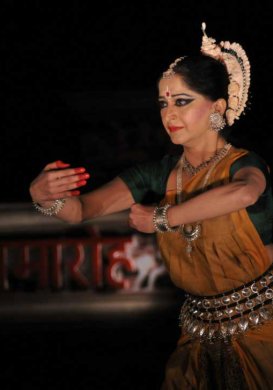 Shagun Bhutani
However, she warmed up in Arabhi pallavi in Ektali, with solfa re re pa ma and in leisurely manner performed the pallavi which had old world charm. The slow speed suited the dance form as resolutions of movements looked beautiful. They gather momentum with progression giving visual shape that goes hand in hand in with music. Shagun chose to present ashtapadi Dhira samire Yamuna teere which has the familiar scene of sakhi requesting Radha to go unto Lord Krishna who is waiting for her, preparing bed of flowers, expecting her, looking for her and even when a leaf falls on the floor, he is startled thinking Radha has arrived. This import of ashtapadi is exquisite and Shagun enacted it with feeling. The ashtapadi demands of a dancer to evoke Krishna's state of mind and dancer has to impersonate Krishna. Shagun did justice maintaining dignity of Krishna in separation. The concluding number in praise of Kali could have been more vigorous. Shagun needs to maintain balance when taking sculpturesque poses as any imbalance results in loss of that quality. The musical accompaniment was by Ramachandra Sahoo (vocal), Prashant Kumar Mangaraj (mardala) and Dhiraj Pandey (flute). Unfortunately, Ramachandra Sahoo's vocal recitation did not help as his voice is no more melodious as it used to be earlier. From Raipur, Yasmin Singh presented Kathak as a group dance telling the story of Lord Shiva in his various manifestations. When Sati (before her incarnation as Parvati) begged of Shiva to attend yagna by her father Daksha, Shiva refused to attend it uninvited. Sati went and suffered humiliation, jumped into fire and died. On learning of it, Lord Shiva with his entourage went and destroyed yagnavedi, picked up Sati's body and performed Tandav unleashing fury. In next birth as Uma, daughter of Himalaya, she performed penance, Kamadeva aimed arrows at the Lord, who opened his third eye and turned Kamadeva into ashes. Parvati and Lord Shiva were married. Yasmin Singh further elaborated the theme with elements of Shakti and Shiva, Kali dancing in violent mood and inadvertently placing her foot on Shiva's chest, was embarrassed and regained peace. The various shlokas, popular bhajans, familiar to the audience succeeded in sustaining interest in the entire production with commendable technique by both male and female dancers, Yasmin taking lead role. In such works, Kathak is shown as a peg and story is enacted with mnemonic syllables of Kathak, footwork and chakkars, and unless balanced with careful editing the production suffers from excess of movements and also katha vastu. Yasmin Singh would do well to keep this in mind. The music by Biswajit Chakravarty was appealing, but more editing of the production would have created better impact. 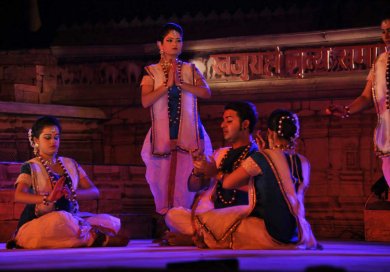 Yasmin Singh and group 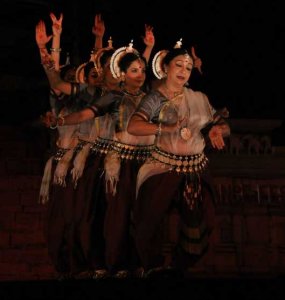 Daksha Mashruwala and group Group choreography of Guru Kelucharan Mohapatra found a felicitous expression in senior dancer Daksha Mashruwala's presentation. A seasoned dancer trained under direct supervision by Kelubabu during his workshops in Mumbai at NCPA, for longer durations, she and other dancers had benefit of Guruji's new compositions and intensive studies like gurukulavasa. It was like 24 X 7 and that foundation showed in her solo and group presentations along with her own choreography of Basant, interpreting Basant as hero with five arrows being thrown on nayikas, intensifying feeling of love, to the music of Asit Desai. Manoj Desai (no relation of Asit Desai) has a melodious voice, an asset bringing out the nuances of the song as in ashtapdi, and evoking mood of the season. Daksha's Dhira samire ashtapadi coming as it did after Shagun Bhutani's presentation, stood out for clarity of movements and choreographic vision of Kelubabu. Using the various level of platform Daksha used the space, showing Krishna looking for Radha's arrival and also preparing the bed of flowers. The falling of a leaf as conceived by Guruji, the bird seating on a branch of a tree and the gentle design the falling leaf created were sheer visual delight. It is a treat to watch such imaginative touches by dancers who had benefit of guruji's direct supervision. Daksha treated Guruji's Durga choreography interpreting each dancer of her troupe, consisting of Namrata Mehta, Subrata Tripathi, Anuradha Sandhavi, Tamanna Tanna, Rubi Jain, as Durga with infinite forms, various weapons and elements, which looked interesting. The finale with Sarva mangalam bhavati, let there be auspiciousness everywhere etc., was evocative. Daksha's Odissi presentation did justice to Guruji imbibing spirit of his dance. 3rd Day Shinjini Kulkarni displayed her taiyyari in Lucknow gharana Kathak following the tradition of her maternal grandfather Pandit Birju Maharaj. She has an attractive stage presence and shows confidence in whatever she performs in terms of technical short numbers like tode, tukde, paran etc. She also created the rhythm of the speed of train with entertaining element of Kathak, dialogues between two friends through mnemonic syllables. Rendering abhinaya to the song by Bindadin Maharaj, depicting Krishna's chhed chhad, pranks, Shinjini followed the tradition she has inherited. However, in this area she has to work more to project expressions convincingly. Kalinath Mishra on tabla, Zohab Hasa, sitar by Naveen Mishra and lighting by Anupam Joshi aka Bunty were adequate. But Shinjini would do well to have a stand by for padhant because that gives time for breathing. 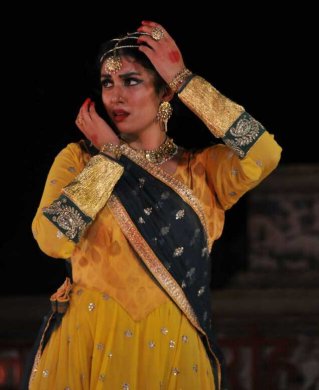 Shinjini Kulkarni 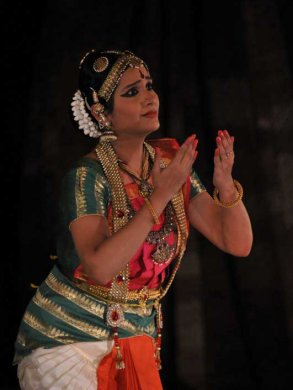 Lavanya Shankar Lavanya Shankar from Coimbatore, a disciple of K.J. Sarasa, stood out for her neat lines and pleasant Bharatanatyam presentation. Accompanied by a team of ace musicians including Murali Parthasarathy (vocal), Sridevi Priya (nattuvangam), K. Parthasarathi (mridangam) and Atul Kumar (flute), Lavanya was in form. Performing Suryashtakam with silhouette looking at Chitragupta temple, with her figure in shadow, she succeeded in creating magic using the space. Prasid mama Bhaskar shloka evoked the devotional mood. It got further enhanced with Kalabhairavashtakam in ragamalika and adi tala. The images of Lord Shiva with damaru, three eyes, form of Kalabhairava; Lord Shiva as nilakanth, suggesting having drunk poison but it stayed near his neck, several resonances were evoked about this presiding deity of Kashi, to whom Tandava is dear. It gave enough scope to Lavanya to create images of Lord Shiva through dance. The balance with which she held poses was admirable. A versatile dancer Lavanya succeeded in creating iconographic images, suggestive and true to the text. In Marathi abhang of Tukaram, rendered with correct recitation of Marathi nuances by Murali Parthasarathy, Lavanya seemed completely absorbed worshipping Vithoba, the deity who stands on the vit, brick, therefore Vithoba. Abhang has a distinct quality and fervour that leads the audience to relish the rasa. The musicians and Lavanya kept the audience in thrall. Her tillana in Nalinkanti raga was scintillating. She covered the stage effortlessly. As a seasoned dancer with solid grounding in dance from an early age under K.J. Sarasa has been a blessing and Lavanya did justice to her guru. Rachana Yadav, daughter of Mannu Bhandari and Rajendra Yadav, the noted eminent names in Hindi literature, studied under Ravi Jain and then under Aditi Mangaldas, working with her Drishtikon Dance Company garnering valuable experience, further enhanced with training under Birju Maharaj's son Jaikishan Maharaj. She and her troupe were impressive. Her literary background helped her in the libretto she used, but editing it for the time constraint would have helped in creating artistic impact. The venue like Khajuraho required such editing. Her solo in Rang de was elaborate, covering all seasons with its variegated moods. But somehow the choreographic work could not lift itself and appeared too long. This is no reflection on Rachana's Kathak. The venue, the constraints of time and other factors need to be considered. She has praiseworthy experience under Aditi Mangaldas. Therefore in terms of presentation and execution it was noteworthy, except that it did not jell. She has to manage to give choreographer's note to give entry point to audiences to her work. 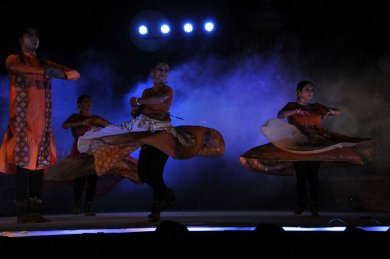 Rachana Yadav and group 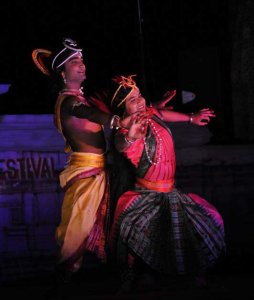 Sadashiva Pradhan's group From Bhubaneswar of the legendary guru Shri Hari Nayak of Mayurbhanj Chhau dance tradition, Sadashiva Pradhan gave energetic performance with his troupe. Kumudbandhu number choreographed by Sadashiva dealt with love between moon and lotus. The abstraction achieved was noteworthy. The two artists who performed brought out the salient features of Mayurbhanj Chhau. But it was Nataraj solo dance which Sadashiva performed that left an indelible impression. He followed his Guru Shri Hari Nayak's style, and had chamak; spasmodic movements - Shiva's three states and moods were depicted well including urdhva tandava posture, lifting the leg upwards. The finale was full of vigour. Sadashiva Pradhan carries on his guru's style faithfully. I missed Chakravyuha number choreographed by Sadashiva Pradhan. Among the present exponents Sadashiva has carved his own niche. 4th Day From USA, Rita Mitra Mustaphi, originally from Kolkata, trained in Kathak by Birju Maharaj brought her company Katha Dance Theatre to present the story of Karna as abandoned hero, using jazz, Western music, singing for the libretto in English written by her. There was vachikabhinaya using dialogues between Karna and Kunti. The story is well known. Kunti goes to Karna revealing to him that he was her son born out of wedlock, son of Surya and therefore he should be on side of Pandavas. Deeply hurt Karna refuses to do so and knows he is to die. There were interesting flashbacks narrating Kunti's begetting son Karna by Surya, her sending him afloat in the river, charioteer's wife Radha raising him. Episode of Draupadi who liked Karna, who wanted to join swayamvara but rejected him as a son of a charioteer, and Karna remembered it, and told Draupadi about insulting him, Draupadi retorted by saying he watched her being humiliated in court when Dushashana disrobed her. Karna laments and tells her that since he is bound to die, he does not want to argue further and both part. In finale, Krishna appears. Karna's death at Arjuna's arrows was foregone conclusion. As unsung hero Karna receives sympathy of spectators. Rita Mustaphi has conceived it well and since she presents it in USA for the audience there, it helps them to understand story of Mahabharata. She has trained in Kathak the American black dancer Derek Phillips who played role of sage Durvasa and Krishna. Anurag trained by Birju Maharaj played role of Karna, Rita Mustaphi as Kunti, Sarika Haris as young Kunti, and Govind as Dushashana. They all did their job well. The original score for Western music was by internationally renowned musician and composer J.D. Steele, Billy Steele and Gretchen Baglysos (vocal). The live music created the mood for collaborative work with interweaving of mnemonic of Kathak. Kathak dancers from Delhi were invited for this production including Aaheli Chakravarty, Yamika Mahesh, Pallavi Dey and Manisha Dixit. It was as a concession and an experiment that the inclusion of this production was presented with a view that it will be appreciated by English speaking foreign tourists. But the large section of Indian audience did not seem to enjoy it as many were Hindi speaking village audience and to them the English dialogue did not make any sense, in spite of the story being told in Hindi. Khajuraho with temple backdrop essentially seems suitable for our traditional languages. And is better suited for mythological stories in Indian classical music and Indian languages be it Sanskrit, Malayalam, Kannada, Tamil, Telugu or Hindi. Audiences respond to it better than such cross cultural productions. 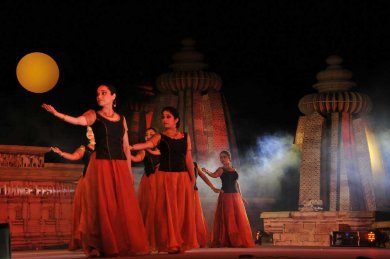 Rita Mustaphi's group 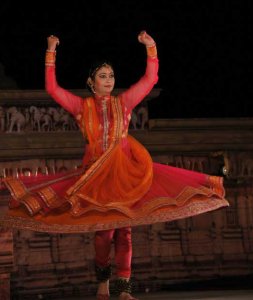 Shikha Khare Kathak solo by Shikha Khare from Delhi was in typical classical Kathak mould. Disciple of Birju Maharaj, Shikha Khare has good experience and she has imbibed style of Lucknow gharana well. She chose vilambit laya fourteen tala and executed anadaz ke thaat, amad suggesting alingan, embrace, chhed chhad, pranks of Krishna and uthaan gracefully. In Madhya laya she presented tihais, chopalli, bedam tihai, paran amad and acquitted in all competently bringing out the essential quality of Kathak. She mentioned that after listening to char tal ki sawari by Zakir Hussain she decided to perform it in Kathak. It was performed competently. The dadra in Pahadi 'Meri gulabi chunariya' was sensuous enough in terms of abhinaya. The team of musicians included Abdul Rehman(tabla), Fatehali Khan (sitar), Suleman Khan (pakhavaj), Zohab Hassan (vocal) and for padhant recitation Vrinda Baheti. Bunty's lighting highlighted few sequences. Disciple of Kalamandalam Sankaranarayanan at Shantiniketan, Pallavi Krishnan moved to Kerala and studied under Kalamandalam Sugandhi and also took guidance from Bharati Shivaji. Pallavi Krishnan and her troupe including Kalamandalam Veena, Shalini, Devika and Navaneetam presented three numbers in Mohiniattam: Ganapati stuti, to the music by late K.N. Panicker, choreographed by Pallavi followed by Gita Govinda ashtapadi, solo by Pallavi, in raga Madhuvanti and tala misra chapu, and Panchabhuta conceived and choreographed by Pallavi to the music composed by Nedumpilli Rammohan and Palakkad Suryanarayanan in Ragmalika and Talamalika. The dancers dressed in typical Mohiniattam costumes with gold border and side buns, looked like apsaras with the backdrop of Chitragupta temple. The leisurely exposition enhanced the beauty of the dance form. In ashtapadi, Radha feeling deceived, sakhi vachanavanchita, thinks of other gopis having company of Krishna, her efforts to walk through forest in dark night, not caring for obstacles like serpent, other animals and when Krishna does not keep his promise, she wants to welcome death. The expressions registered on Pallavi's face were commensurate with the text and evocative. She has over the years worked on abhinaya aspect with success. Not mere lasya movements of Mohiniattam but has also explored thematically with emotions that result into rasa. Panchamahabhuta is a complex theme. Beginning with depiction of Shakti as source and five elements ether, wind, fire, water and earth, Pallavi related the theme to Yoga. Every human being has seven chakras, energy centres, located along a central vertical axis of the spine. Kundalini resides in Mooladhara chakra at the base of the spine in coils like serpent. Pallavi took from Soundaryalahari of Sankaracharya the concept of five cosmic elements corresponding to the lower five chakras. The interpretation was performed with hastas and angikabhinaya to suggest the content in a delectable manner. Kundalini finally reaching Sahasrara chakra making human beings feel the truth, is indeed a difficult concept to perform through dance. Pallavi succeeded in conveying this concept through Mohiniattam dance form. She had assistance from Prof Sundaksarana in selecting shlokas from Soundaryalahari and Taittriya Upanishad. To explore themes like Panchabhuta in a graceful manner with excellent music and well trained dancers, Pallavi deserves congratulations. 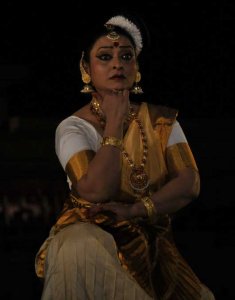 Pallavi Krishnan 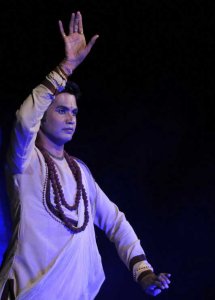 Sandip Mallick
The final artist was Sandip Mallick from Kolkata. Trained by Shrilekha Mukherjee he has further received training under Birju Maharaj, Bela Arnab, Chitresh Das and others of Lucknow gharana during various workshops. He has choreographed interesting dance works in Kathak. I had an occasion to see his choreography in a festival at Durgapur and was impressed by his assimilating various Kathak schools in a smooth manner. In his solo he displayed his taiyyari. Unfortunately it was rather late and I could not see his complete presentation. Part 2  Dr. Sunil Kothari is a dance historian, scholar, author and critic. He is honored with Padma Shri, Sangeet Natak Akademi award and Senior Critic Award from Dance Critics Association, NYC. Post your comments Please provide your name and email id when you use the Anonymous profile in the blog to post a comment. All appropriate comments posted with name & email id in the blog will also be featured in the site. |